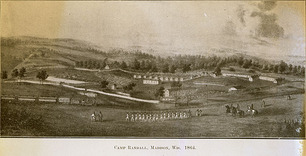Lesson 5: Wisconsin Prepares For War

Camp Randall
Lesson Essential Question:
How did Wisconsin get ready for the war?
What was daily life and training like for soldiers?
How did Wisconsin get ready for the war?
What was daily life and training like for soldiers?
NCSS Standards:
MMSD Standards:
UW Teaching Standards:
Materials Needed:
o Zeitlin, R. (1986). Old Abe the War Eagle. Madison, WI: The State Historical Society of Wisconsin.
o Stanchak, J. (2000). Civil War. New York, NY: Dorling Kindersley Publishing, Inc.
Objectives:
Lesson Context:
The students have just learned how the Civil War began and now will be learning more about how Wisconsin was affected. They will also explore what life was like for Union soldiers.
Lesson Opening:
I will explain to students that today we will be discussion how people in Wisconsin were affected by the Civil War. We will learn about the soldiers from Wisconsin as well as what other roles people took on.
Procedures:
Closing:
I will facilitate a brief discussion with students about their reactions to what they learned about Camp Randall and what life was like for the soldiers.
Assessment:
Since this lesson is mostly lecture, reading, and discussion based, the students will not be formally assessed. Rather I will be informally assessing students on their understanding of the reading and participating in discussions.
- Standard 3: People, Place, and Environments
- Standard 6: Power, Authority, and Governance
- Standard 10: Civic Ideals and Practices
MMSD Standards:
- Students will:
UW Teaching Standards:
- Standard 3: demonstrates sophisticated curricular knowledge
- Standard 11: uses technologies
Materials Needed:
- Book:
o Zeitlin, R. (1986). Old Abe the War Eagle. Madison, WI: The State Historical Society of Wisconsin.
o Stanchak, J. (2000). Civil War. New York, NY: Dorling Kindersley Publishing, Inc.
- Laptop and projector
- Document Camera
- PowerPoint Presentation
- 'Causes and Effects Leading to the Civil War' Sheets
Objectives:
- Students will learn that many Wisconsin soldiers were trained at Camp Randall
- Students will examine images and drawings of Camp Randall from the 1800s and describe what they see
- Students will discuss what life and training was like for Wisconsin soldiers
Lesson Context:
The students have just learned how the Civil War began and now will be learning more about how Wisconsin was affected. They will also explore what life was like for Union soldiers.
Lesson Opening:
I will explain to students that today we will be discussion how people in Wisconsin were affected by the Civil War. We will learn about the soldiers from Wisconsin as well as what other roles people took on.
Procedures:
- First I will ask students to raise their hands if they have been to Camp Randall before.
- I will show them a slide from my PowerPoint of what Camp Randall looks like now. Then I will change to the next slide that has an illustration of what Camp Randall looked like in the 1800s. I will ask students what they notice.
- The next slide has a picture of Governor Alexander W. Randall. I will explain that Camp Randall was named after this man who was the Governor of WI during the beginning of the Civil War.
- I will leave this slide up on the projector and then we will begin to read page 129 ‘How did Wisconsin get ready for war?’
- I will stop the reading to show a picture of Camp Randall in 1861. Again I will ask students to explain what they see in the illustration (troops marching, fences, buildings, train, etc.)
- During the reading and PowerPoint presentation, I will explain how soldiers were trained at Camp Randall before going to battle.
- We will also pause to define terminology: regiment, troops, drill, recruiting
- After we finish reading page 129 together and discuss the pictures in the slide show, we will fill in the last two questions on our 'Causes and Effects' Sheet. Students will discuss the effects these causes had: - President Lincoln calls for troops from all Union States - Governor Randall wants all Wisconsin troops trained
- Next I will read some samples about Wisconsin troops from the book Old Abe The War Eagle to give the students an idea about what life was like at Camp Randall for the soldiers. There are photographs of Wisconsin soldiers in this book as well, so students will have an opportunity to learn more about regiments from WI.
- We will discuss the uniforms soldiers were issued, the weapons they used, the type of drills and marching they engaged in, camp life, food, etc.
- I will also show them images of typical soldier uniforms, weapons, and supplies from the book 'Civil War'
Closing:
I will facilitate a brief discussion with students about their reactions to what they learned about Camp Randall and what life was like for the soldiers.
Assessment:
Since this lesson is mostly lecture, reading, and discussion based, the students will not be formally assessed. Rather I will be informally assessing students on their understanding of the reading and participating in discussions.
